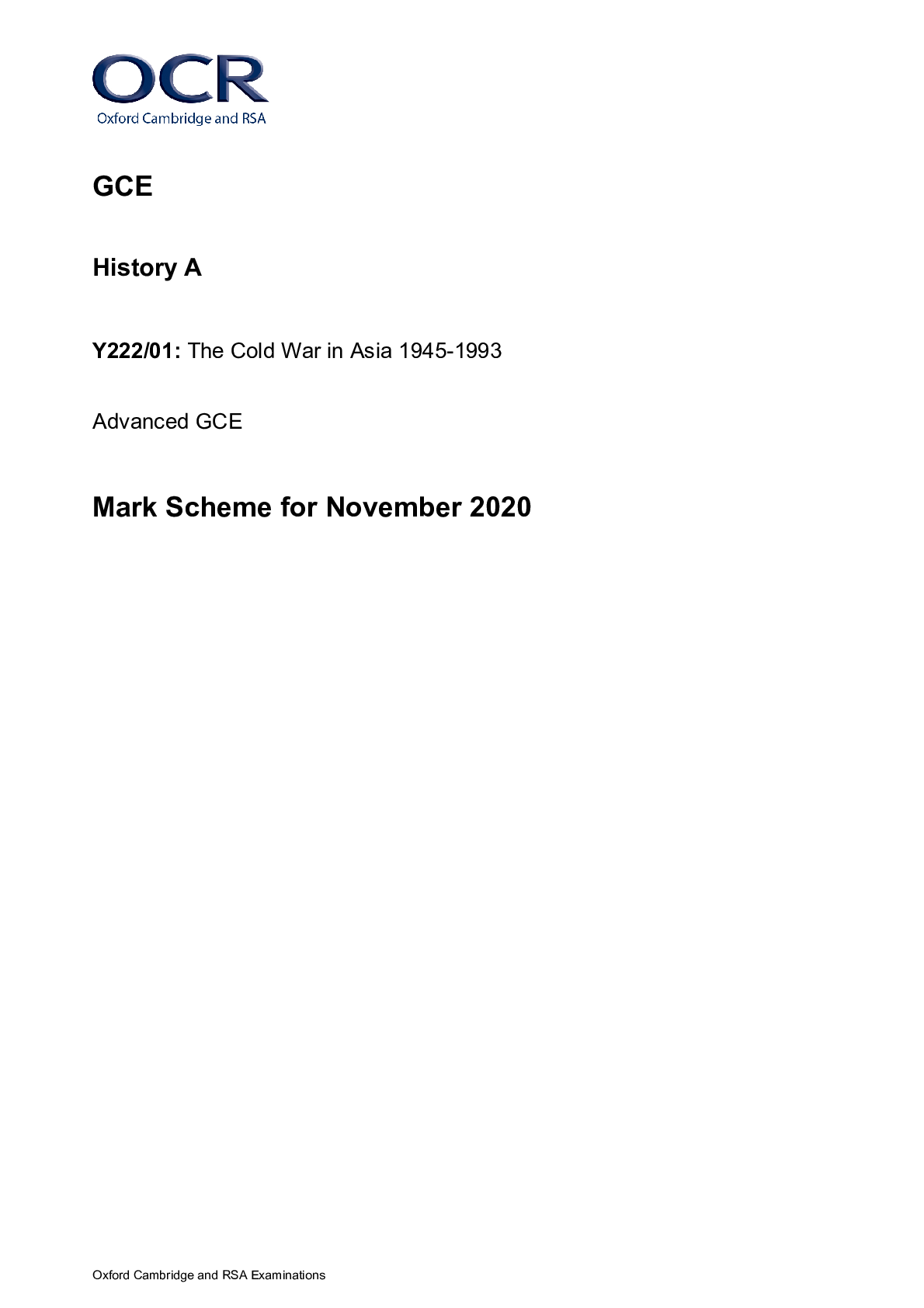Mathematics > AS Mark Scheme > GCE Further Mathematics A Y541/01: Pure Core 2 Advanced GCE Mark Scheme for November 2020 (All)
GCE Further Mathematics A Y541/01: Pure Core 2 Advanced GCE Mark Scheme for November 2020
Document Content and Description Below
Oxford Cambridge and RSA Examinations GCE Further Mathematics A Y541/01: Pure Core 2 Advanced GCE Mark Scheme for November 2020Oxford Cambridge and RSA Examinations OCR (Oxford Cambridge and RSA... ) is a leading UK awarding body, providing a wide range of qualifications to meet the needs of candidates of all ages and abilities. OCR qualifications include AS/A Levels, Diplomas, GCSEs, Cambridge Nationals, Cambridge Technicals, Functional Skills, Key Skills, Entry Level qualifications, NVQs and vocational qualifications in areas such as IT, business, languages, teaching/training, administration and secretarial skills. It is also responsible for developing new specifications to meet national requirements and the needs of students and teachers. OCR is a not-for-profit organisation; any surplus made is invested back into the establishment to help towards the development of qualifications and support, which keep pace with the changing needs of today’s society. This mark scheme is published as an aid to teachers and students, to indicate the requirements of the examination. It shows the basis on which marks were awarded by examiners. It does not indicate the details of the discussions which took place at an examiners’ meeting before marking commenced. All examiners are instructed that alternative correct answers and unexpected approaches in candidates’ scripts must be given marks that fairly reflect the relevant knowledge and skills demonstrated. Mark schemes should be read in conjunction with the published question papers and the report on the examination. © OCR 2020Y541/01 Mark Scheme November 2020 2 Text Instructions Annotations and abbreviations Annotation in RM assessor Meaning and BOD Benefit of doubt FT Follow through ISW Ignore subsequent working M0, M1 Method mark awarded 0, 1 A0, A1 Accuracy mark awarded 0, 1 B0, B1 Independent mark awarded 0, 1 SC Special case ^ Omission sign MR Misread BP Blank Page Seen Highlighting Other abbreviations in mark scheme Meaning dep* Mark dependent on a previous mark, indicated by *. The * may be omitted if only one previous M mark cao Correct answer only oe Or equivalent rot Rounded or truncated soi Seen or implied www Without wrong working AG Answer given awrt Anything which rounds to BC By Calculator DR This question included the instruction: In this question you must show detailed reasoning.Y541/01 Mark Scheme November 2020 3 Subject-specific Marking Instructions for A Level Mathematics A a Annotations must be used during your marking. For a response awarded zero (or full) marks a single appropriate annotation (cross, tick, M0 or ^) is sufficient, but not required. For responses that are not awarded either 0 or full marks, you must make it clear how you have arrived at the mark you have awarded and all responses must have enough annotation for a reviewer to decide if the mark awarded is correct without having to mark it independently. It is vital that you annotate standardisation scripts fully to show how the marks have been awarded. Award NR (No Response) - if there is nothing written at all in the answer space and no attempt elsewhere in the script - OR if there is a comment which does not in any way relate to the question (e.g. ‘can’t do’, ‘don’t know’) - OR if there is a mark (e.g. a dash, a question mark, a picture) which isn’t an attempt at the question. Note: Award 0 marks only for an attempt that earns no credit (including copying out the question). If a candidate uses the answer space for one question to answer another, for example using the space for 8(b) to answer 8(a), then give benefit of doubt unless it is ambiguous for which part it is intended. b An element of professional judgement is required in the marking of any written paper. Remember that the mark scheme is designed to assist in marking incorrect solutions. Correct solutions leading to correct answers are awarded full marks but work must not always be judged on the answer alone, and answers that are given in the question, especially, must be validly obtained; key steps in the working must always be looked at and anything unfamiliar must be investigated thoroughly. Correct but unfamiliar or unexpected methods are often signalled by a correct result following an apparently incorrect method. Such work must be carefully assessed. When a candidate adopts a method which does not correspond to the mark scheme, escalate the question to your Team Leader who will decide on a course of action with the Principal Examiner. If you are in any doubt whatsoever you should contact your Team Leader.Y541/01 Mark Scheme November 2020 4 c The following types of marks are available. M A suitable method has been selected and applied in a manner which shows that the method is essentially understood. Method marks are not usually lost for numerical errors, algebraic slips or errors in units. However, it is not usually sufficient for a candidate just to indicate an intention of using some method or just to quote a formula; the formula or idea must be applied to the specific problem in hand, e.g. by substituting the relevant quantities into the formula. In some cases the nature of the errors allowed for the award of an M mark may be specified. A method mark may usually be implied by a correct answer unless the question includes the DR statement, the command words “Determine” or “Show that”, or some other indication that the method must be given explicitly. A Accuracy mark, awarded for a correct answer or intermediate step correctly obtained. Accuracy marks cannot be given unless the associated Method mark is earned (or implied). Therefore M0 A1 cannot ever be awarded. B Mark for a correct result or statement independent of Method marks. Unless otherwise indicated, marks once gained cannot subsequently be lost, e.g. wrong working following a correct form of answer is ignored. Sometimes this is reinforced in the mark scheme by the abbreviation isw. However, this would not apply to a case where a candidate passes through the correct answer as part of a wrong argument. d When a part of a question has two or more ‘method’ steps, the M marks are in principle independent unless the scheme specifically says otherwise; and similarly where there are several B marks allocated. (The notation ‘dep*’ is used to indicate that a particular mark is dependent on an earlier, asterisked, mark in the scheme.) Of course, in practice it may happen that when a candidate has once gone wrong in a part of a question, the work from there on is worthless so that no more marks can sensibly be given. On the other hand, when two or more steps are successfully run together by the candidate, the earlier marks are implied and full credit must be given. e The abbreviation FT implies that the A or B mark indicated is allowed for work correctly following on from previously incorrect results. Otherwise, A and B marks are given for correct work only – differences in notation are of course permitted. A (accuracy) marks are not given for answers obtained from incorrect working. When A or B marks are awarded for work at an intermediate stage of a solution, there may be various alternatives that are equally acceptable. In such cases, what is acceptable will be detailed in the mark scheme. If this is not the case please, escalate the question to your Team Leader who will decide on a course of action with the Principal Examiner. Sometimes the answer to one part of a question is used in a later part of the same question. In this case, A marks will often be ‘follow through’. In such cases you must ensure that you refer back to the answer of the previous part question even if this is not shown within the image zone. You may find it easier to mark follow through questions candidate-by-candidate rather than question-by-question. f We are usually quite flexible about the accuracy to which the final answer is expressed; over-specification is usually only penalised where the scheme explicitly says so. • When a value is given in the paper only accept an answer correct to at least as many significant figures as the given value.Y541/01 Mark Scheme November 2020 5 • When a value is not given in the paper accept any answer that agrees with the correct value to 3 s.f. unless a different level of accuracy has been asked for in the question, or the mark scheme specifies an acceptable range. NB for Specification B (MEI) the rubric is not specific about the level of accuracy required, so this statement reads “2 s.f”. Follow through should be used so that only one mark in any question is lost for each distinct accuracy error. Candidates using a value of 9.80, 9.81 or 10 for g should usually be penalised for any final accuracy marks which do not agree to the value found with 9.8 which is given in the rubric. g Rules for replaced work and multiple attempts: • If one attempt is clearly indicated as the one to mark, or only one is left uncrossed out, then mark that attempt and ignore the others. • If more than one attempt is left not crossed out, then mark the last attempt unless it only repeats part of the first attempt or is substantially less complete. • if a candidate crosses out all of their attempts, the assessor should attempt to mark the crossed out answer(s) as above and award marks appropriately. h For a genuine misreading (of numbers or symbols) which is such that the object and the difficulty of the question remain unaltered, mark according to the scheme but following through from the candidate’s data. A penalty is then applied; 1 mark is generally appropriate, though this may differ for some units. This is achieved by withholding one A or B mark in the question. Marks designated as cao may be awarded as long as there are no other errors. If a candidate corrects the misread in a later part, do not continue to follow through. Note that a miscopy of the candidate’s own working is not a misread but an accuracy error. i If a calculator is used, some answers may be obtained with little or no working visible. Allow full marks for correct answers, provided that there is nothing in the wording of the question specifying that analytical methods are required such as the bold “In this question you must show detailed reasoning”, or the command words “Show” or “Determine”. Where an answer is wrong but there is some evidence of method, allow appropriate method marks. Wrong answers with no supporting method score zero. If in doubt, consult your Team Leader. j If in any case the scheme operates with considerable unfairness consult your Team Leader.Y541/01 Mark Scheme November 2020 6 Question Answer Marks AO Guidance 1 DR 20 ( 20) 4 4 169 2 2 4 z − − ± − − × × = × M1 1.1 Term by term substituting into formula. If formula quoted, allow one slip ... Or correctly completes the square Condone anything correct of the form p q r ± eg 2 5 25 4 169 0 2 4 z − − + = 5 12i 2 z ± = A1 1.1 2 2 5 12 13 2 2 2 r = + = oe B1ft 1.1 Ft workings from complex conjugate distinct pair (with real component) 1 6 tan 2.5 θ = − oe M1 1.1 Attempting to find argument using trigonometry 1 2.5 cos , 6.5 θ = − sin 1 6 6.5 θ = − 13(cos1.18 isin1.18) 2 + 13(cos( 1.18) isin( 1.18)) 2 − + − A1 2.5 Angle must be in radians. oe eg 13 cis1.18 2 or 13 , 1.18 2 Argument could be 5.11 but both angles must be the same. Not 5.10 (rounding error) Not e.g. cos( 1.18) isin(5.11) − + [5]Y541/01 Mark Scheme November 2020 7 Question Answer Marks AO Guidance 2 (a) DR u = x2 B1 3.1a Correct substitution chosen 3 2 5 4 ( 0) ( u u u )3 2 − − − = ( ) M1 1.1 Oe Attempting to make substitution or preparation for substitution by removing odd powers. eg x2(3x2 – 5)2 = (2x2 + 4)2... 3 5 2 4 (3 5) (2 4) u u u u u u u − = + ⇒ − = + 2 2 M1 1.1 Rearranging and squaring bs to remove the square root(s) ...and then substituting u(3u – 5)2 = (2u + 4)2 u(9u2 – 30u + 25) = 4u2 + 16u + 16 => 9u3 – 34u2 + 9u – 16 = 0 A1 3.2a Rearranging to answer Equation can be in x Alternative method DR ( ) 2 2 2 2 2 4 16 3 9 α β γ αβγ = = − = − B1 Must include one intermediate step ( ) 2 2 2 2 2 2 2 2 ( ) α β β γ γ α αβ βγ γα αβγ α β γ + + = + + − + + M1 Writing the expression in terms of standard symmetrical forms NB ∑α = 2 3 , ∑αβ = − 53 , 43 αβγ = α β γ α β γ αβ βγ γα 2 2 2 + + = + + − + + ( )2 2( ) M1 Writing the expression in terms of standard symmetrical forms Condone without factorisation of “2” 2 2 3 2 3 2 3 2 2 5 5 4 2 16 2 2 3 3 3 3 3 9 34 16 0 9 34 9 16 0 9 9 u u u u u u u u u − − − − × + − × × − = − + − = ⇒ − + − = A1 Substituting in and rearranging to answer NB 2 34 , 9 ∑α = ∑α β 2 2 =1 [4] 2 (b) DR ( ) ( ) ( ) 2 2 9 9 4 4 3 3 1 or α β αβγ = ∑ M1 3.1a Theirα β β γ γ α 2 2 2 2 2 2 + + from part (a) over ± 4 3 Strict ftY541/01 Mark Scheme November 2020 8 34 = A1 1.1 [2] Question Answer Marks AO Guidance 3 (a) DR (r + 2)(r – 1) B1 1.1 Correct factorisation of denominator soi 1 2 A B r r + − + M1 1.1 Correct form for partial fractions A = 1, B = –1 A1 1.1 2 5 5 5 3 5 8 7 3 5 1 3 1 1 2 1 2 1 1 1 1 1 1 1 1 n n n r r r n n r r n r r n r r r r r r r r = = = + = = + = = + ∴ = − + − − + = − − − = − − − ∑ ∑ ∑ ∑ ∑ ∑ ∑ M1 1.1 Using partial fractions, separating into two sums, re-indexing so that the summands have identical form and cancelling central terms. Might see start and end terms explicitly. eg 3 5 8 8 8 1 1 1 1 1 1 1 1 5 1 6 1 7 1 1 1 1 1 1 1 1 2 n n r r n r n r r r r r n n n + = = = = − − − = + + + − − − − − + + + − + + ∑ ∑ ∑ ∑ Might see formal substitution of index. eg 5 5 3 5 8 Let 3 2 1 1 1 1 2 1 1 1 1 n n r r n n r R R r r R r r r R = = + = = = + ⇒ + = − ∴ − − + = − − − ∑ ∑ ∑ ∑Y541/01 Mark Scheme November 2020 9 2 5 3 2 1 1 1 1 1 1 4 5 6 1 2 37 1 1 1 60 1 2 n r r r n n n n n n = ∴ = + − = + + − − − + + = − − − + + ∑ A1 1.1 AG. Question Answer Marks AO Guidance Alternative method for last 2 marks: = 1 4 - 1 7 … - 1 � −1 1 5 - 1 8 1 � − 3 - 1 � 1 6 - 1 9 1 � − 2 - 1 � + 1 1 7 - … 1 � − 1 - 1 � + 2 M1 At least these terms M1 can be ft from any A, B having opposite signs For M1, condone omission of 1 7 or - 1 n −1 1 1 1 1 1 1 4 5 6 1 2 37 1 1 1 60 1 2 n n n n n n = + + − − − + + = − − − + + A1 AG. Correct cancellation to AG. Requires joined argument Must have either clear diagonal cancellations with one explicit cancellation or less clear cancellation with numerical and algebraic cancellation shown or described [5] (b) 37 60 = or awrt 0.617 B1 2.2a [1]Y541/01 Mark Scheme November 2020 10 4 (a) 13 1 3 5 13 15 42 14 14 3 = + − = − . − (so R is on Π) B1 1.1 AG. Intermediate working must be seen eg 7 – µ = 13 => µ = –6 => 7 1 13 9 6 1 3 2 2 14 − = − = − − r (so R is also on l2) B1 1.1 AG. Or 9 + µ = 3 or – 2 + 2µ = –14 but must be checked in other two equations. Alternate method 1 7 1 5 9 1 46 10 14 6 3 2 2 µ µ µ − + = + = − ⇒ = − . − M1 AG. Substituting in expression of the point into the equation of the plane to find a value for µ µ = –6 => 7 1 13 9 6 1 3 2 2 14 − = − = − − r so R is (13, 3, –14) A1 AG. Answer in vector form is acceptable. [2] (b) Since lines intersect 1 2 7 1 0 1 9 1 a 3 2 2 λ µ − + = + − − for some λ and µ so 1 2 7 + = − λ µ 9λ µ= +( a − = − + 3 2 2 λ µ ) M1 3.1a Equating the lines and deriving 2 useful equations. Ignore attempts at z coefficient equation ⇒ = = − λ µ 5, 4 A1 1.1 Can be BC so a + 5×(–3) = –2 + (–4)×2 => a = 5 A1ft 1.1Y541/01 Mark Scheme November 2020 11 At Q, 1 2 1 0 1 5 14 5 3 3 λ + = − . − for some λ so 1 + 5×3 + λ(2 + 5 + (–3)×3) = –14 *M1 2.1 Substituting general r from l1 into the Π equation and dotting out to form an equation in λ Accept algebraic expressions in a until final A mark –2λ = –30 => λ = 15 => Q(31, 15, –40) A1 1.1 λ = + 7.5 1.5a (16 3 , 7.5 1.5 , 22.5 3.5 ) Q a a a + + − − Question Answer Marks AO Guidance (31 13) (15 3) ( 40 14) − + − + − − − 2 2 2 dep*M 1 2.1 Method fully shown or at least 2 of 3 squared terms correct Depends on correct method shown to find Q 2 2 2 (3 3 ) (4.5 1.5 ) ( 8.5 3.5 ) a a a + + + + − − = + + = 18 12 26 1144 2 2 2 A1 3.2a 2√286 [7] 5 (a) AE: m2 – 2m – 15 = 0 => m = 5 or –3 M1 1.1 So GS is Q A B = + e e −3 5 t t A1 1.1 Q tends to finite limit as t → ∞ => B = 0 B1 2.2a Or dQ/dt tends to zero as t → ∞ www t = 0, Q = 100 => A = 100 M1 3.4 Using initial condition to find A (or A + B) So Q =100e−3t A1 1.1 soi t = 0.5 ⇒ = = Q 100e 22.3 −1.5 A1 3.4 [6] (b) (As t → ∞ e 0 −3t → so Q tends to) 0. B1 3.4 Only if from Q k = e , −at a > 0 It must be clear that the limit is 0; “Q is approximately 0” would not be sufficient for B1. [1]Y541/01 Mark Scheme November 2020 12 6 (a) ln(1 + sinθ) = 0 => 1 + sinθ = 1 => sinθ = 0 M1 1.1a so α = 0 and β = π A1 2.2a [2] (b) 2 0 1 (ln(1+sin )) d 2 A π = θ θ ∫ M1 1.2 Correct formula for area with correctly substituted and their r limits. Must be unambiguous but can be implied by correct answer/later work Incorrect formula = M0A0 Condone missing dθ = 0.4162 (4 sf) cao A1 1.1 BC [2] Question Answer Marks AO Guidance (c) ln 2 0.6931 (4 sf) 2 r π θ = ⇒ = = which would be the diameter, D, of the circle M1 3.1a or radius R = 0.3466 (4 sf) condone correct R or D without reasoning It must be clear that the r value would be the diameter of the circle; the calculation alone is insufficient for M1. M1 can be implied by area given as 2 ln 2 2 π But A = 0.4162 (4 sf) => D = 0.7280 (4 sf) or R = 0.3640 (4 sf) so the curve is not circular A1 3.2a or R = 0.3466 (4 sf) (or D = 0.6931) => A = 0.3773 (4 sf) which is not 0.4162 (4 sf) Explanation must include comparison of R’s, D’s or A’s and conclusion . Allow correct working to 3 sf. [2] 7 (a) detA (= 0.6×1.8 – –0.8×2.4) = 3 B1 1.1 [1] (b) Determinant of rotation = 1 B1 1.1 Determinant of rotation × determinant of stretch = 1×sf = 3 => sf = 3 B1 2.2a [2]Y541/01 Mark Scheme November 2020 13 (c) Since the second column of A contains entries bigger than 1 (in magnitude) the stretch must be parallel to the y-axis. B1 2.4 Or any correct, complete explanation. May see cos sin 1 0 sin cos 0 3 cos 3sin sin 3cos θ θ θ θ θ θ θ θ − − = or similar [1] (d) sinθ = –0.8 and cosθ = 0.6 oe M1 2.2a Condone if only one equation awrt –53° (or –0.93 rads) A1 1.1 or 53° (0.93 rads) clockwise or 307° (5.36 rads) (anticlockwise). [2] Question Answer Marks AO Guidance 8 (a) DR r 2 = − + ( 4 48 )2 ( )2 or (rcosθ = –4 and rsinθ = √48) or tanθ = –√3 oe M1 2.1 Correct use of relevant formula(e). Some working must be seen. Correct answer with no working: M0A0 r = 8 (ie z = 8eiθ) θ = 2π/3 (ie z = rei2π/3) A1 1.1 Not ±8 unless later corrected or eg θ = 8π/3 3 8 or 2 B1ft 2.1 Modulus of cube root(s) is the cube root of their modulus 2π 9 soi B1ft 2.1 Argument of (principal) cube root is one third of their argument 2 2 3 π + π k for k = 1 and 2 oe seen M1 2.2a Considering further arguments at angular distance 2π 2 8 4 2e , 2e and 2e 9 9 9 π π π i i i − A1 1.1 or eg 2 8 14 2e , 2e and 2e 9 9 9 π π π i i i Must be in exponential form, not just r = and θ =. Do not condone any missing i’s. [6] (b) DR The cube roots form an equilateral triangle which has (3) lines of symmetry, (one) through each vertex B1 2.2aY541/01 Mark Scheme November 2020 14 2 8 4 , and 9 9 9 π π π θ θ θ = = = − soi B1 B1 2.2a 2.2a for one for all three without extras ft their angles if 2π/3 apart. If valid alternatives, must come from clear explanation/diagram [3] Question Answer Marks AO Guidance 9 (a) Min value of cosh is 1 (and point on ground is at the minimum) M1 2.2a Using minimum point of curve and knowledge of cosh graph Could be derived by differentiation (so 0 = k×1 – 1 =>) k = 1 A1 2.2a If zero scored then sc1 for k=1 www [2] (b) Passes through (0, 3) => 3 = cosh(–b) – 1 => b = –cosh–1(3 + 1) *M1 3.3 Use of (0, 3) to derive an expression for b accept cosh(−�) = 4 � b = (±)ln(4 + √(42 – 1)) dep*M 1 3.1a Correct numerical use of formula Or rearranges. => b = ln(4 + √15) A1 1.1 Passes through (2, 0) => 0 = cosh(2a – b) – 1 => b = 2a M1 3.3 Use of (2, 0) to derive b = 2a Could be from (a). Allow ft => a = ½ln(4 + √15) A1 1.1 [5] (c) (By symmetry of both;) (4, 3) B1 2.2a [1] (d) Holly’s model; dH = 6.75 B1 3.4 Condone 27/4Y541/01 Mark Scheme November 2020 15 Jofra’s model: dJ = cosh(5a – b) – 1 M1 3.4 Use of x = 5 with their values of a and b to predict d. Must have – 1 a = 1.0317..., b = 2.0634..., dJ = 10.067... Condone 10.07 only if clear evidence of production AG dJ – dH = 10.067... – 6.75 = 3.32 (3 sf) A1 1.1 From correct values [3]Y541/01 Mark Scheme November 2020 16 Question Answer Marks AO Guidance 10 (a) (i) ( 2 ) 12 1 f ( ) 1 x x ′ = − from the formula book so ( ) 3 ( ) 2 12 2 1 f ( ) . . 2 1 x x x ′′ = − − − M1 1.1 Formula from the Formula Booklet and attempt differentiation To within sign error (1 2 ) 32 x x = − A1 1.1 [2] (a) (ii) f (0) 0 = , f (0) 1 ′ = and f (0) 0 ′′ = B1 1.1 or a0 = 0, a1 = 1 and a2 = 0 Ignore sign error in f ( ) ′′ x f ′′′(�) = (1 − �2) 3 2 − �. 32 �1 −�2� 1 2 .(−2�) (1 − �2)3 M1 3.1a Differentiate and simplify far enough to be able to justify value 1 Either full derivative or “zero term” denoted as such so f (0) 1 ′′′ = and f ( ) ... x x x = + + 16 3 A1 2.1 Condone 3! In place of 6 Not BC. If M0 then SC1 for correct expansion [3] (a) (iii) 1 1 2 2 1 3 6 0 0 ∫ ∫ f ( )d x x x x x ≈ + d M1 1.1 Integral of their 2 term cubic with limits = 0.127604167... = 0.127604 to 6 dp A1 1.1 Could be BC [2] (b) 2 1 1 1 1 sin d sin d x x x x x x x − − − ∫ ∫ × = − M1 3.1a Attempt integration by parts ignore limits must be correct . Formula for parts = + − x x x sin 1 −1 2 ( ) 12 (+c) A1 1.1 �01 2f(�) = 12 � + √23 − 1 A1 1.1 [3]OCR (Oxford Cambridge and RSA Examinations) The Triangle Building Shaftesbury Road Cambridge CB2 8EA OCR Customer Contact Centre ed [Show More]
Last updated: 1 year ago
Preview 1 out of 18 pages

Reviews( 0 )
Document information
Connected school, study & course
About the document
Uploaded On
Oct 11, 2022
Number of pages
18
Written in
Additional information
This document has been written for:
Uploaded
Oct 11, 2022
Downloads
0
Views
43








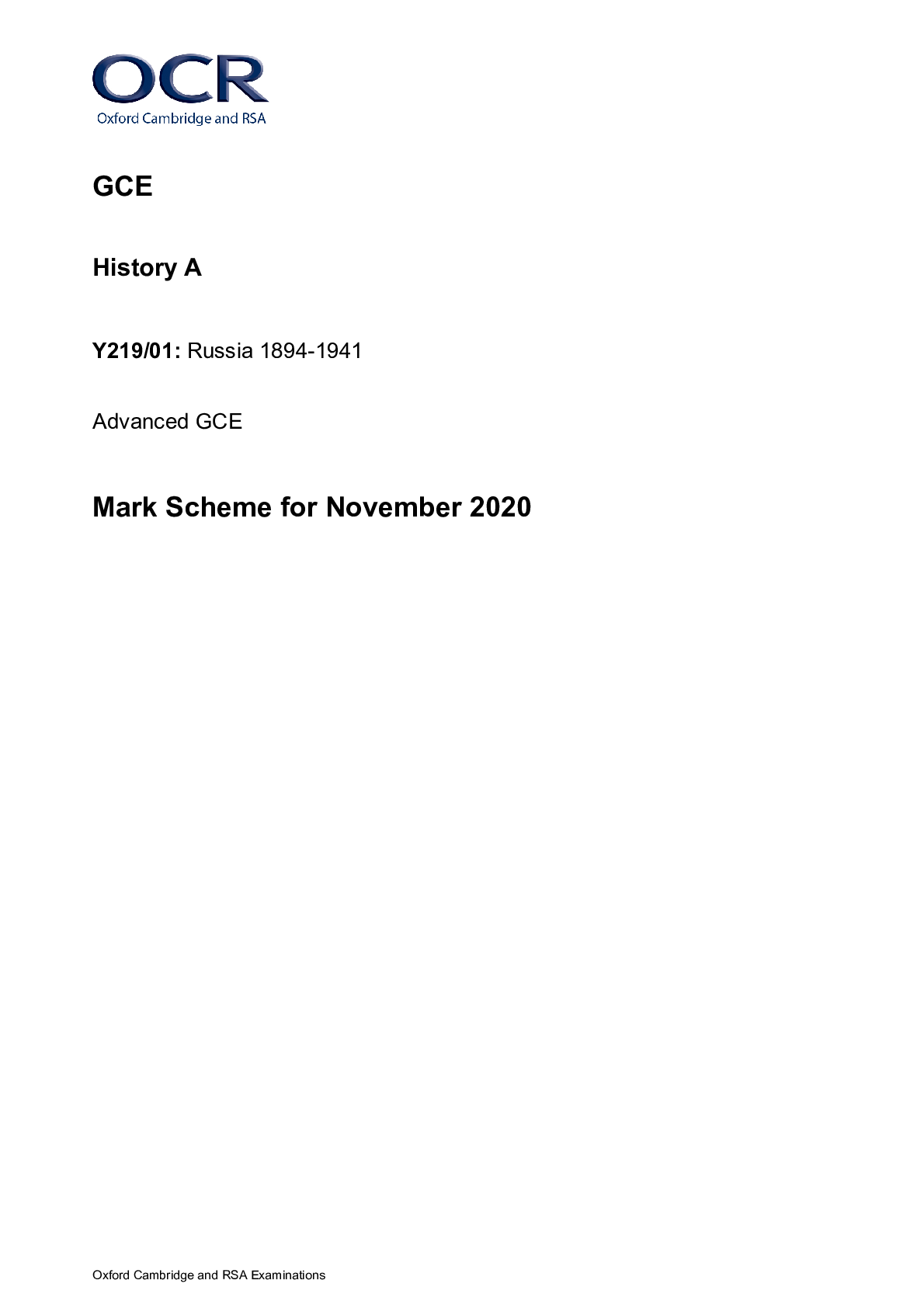
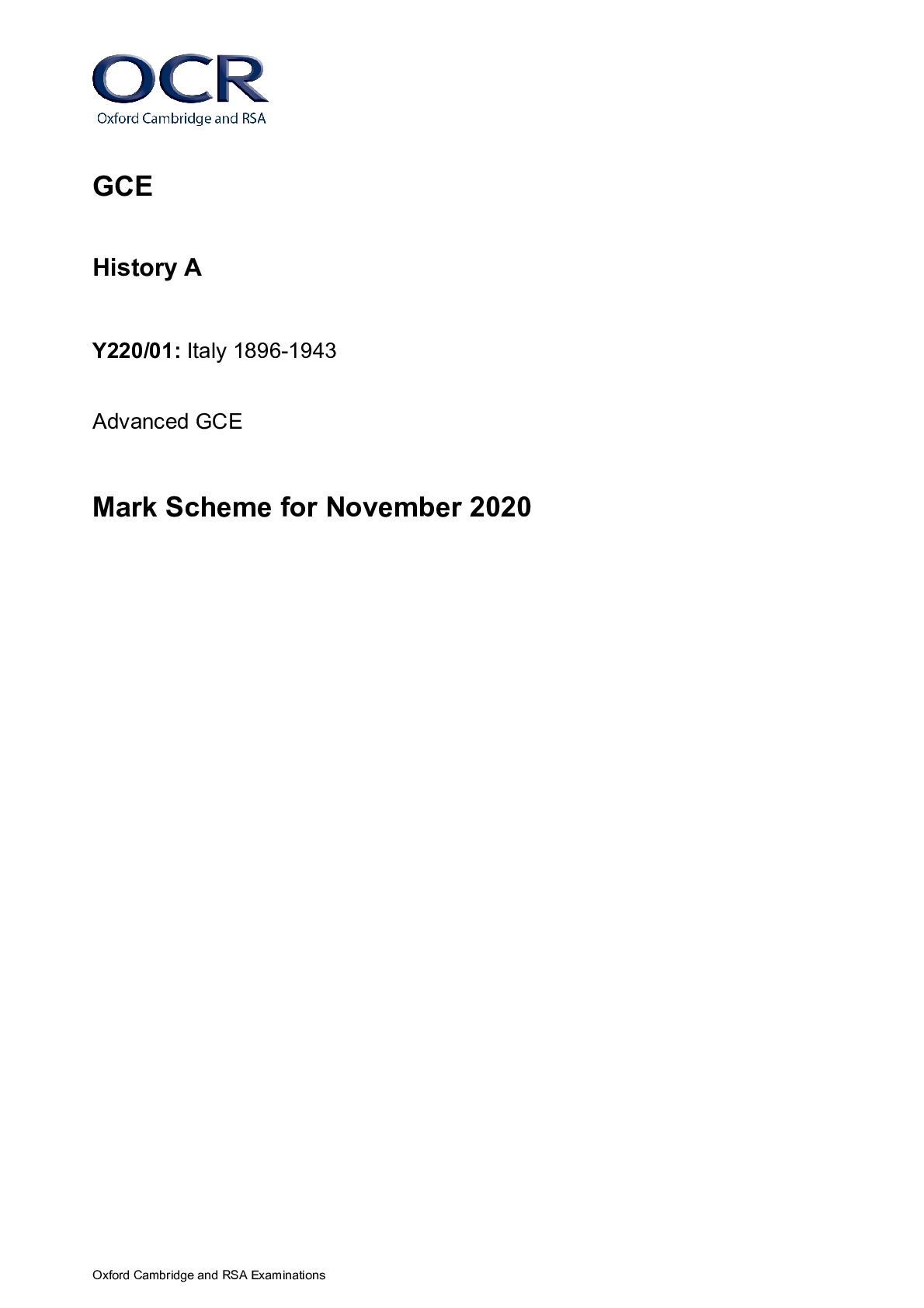

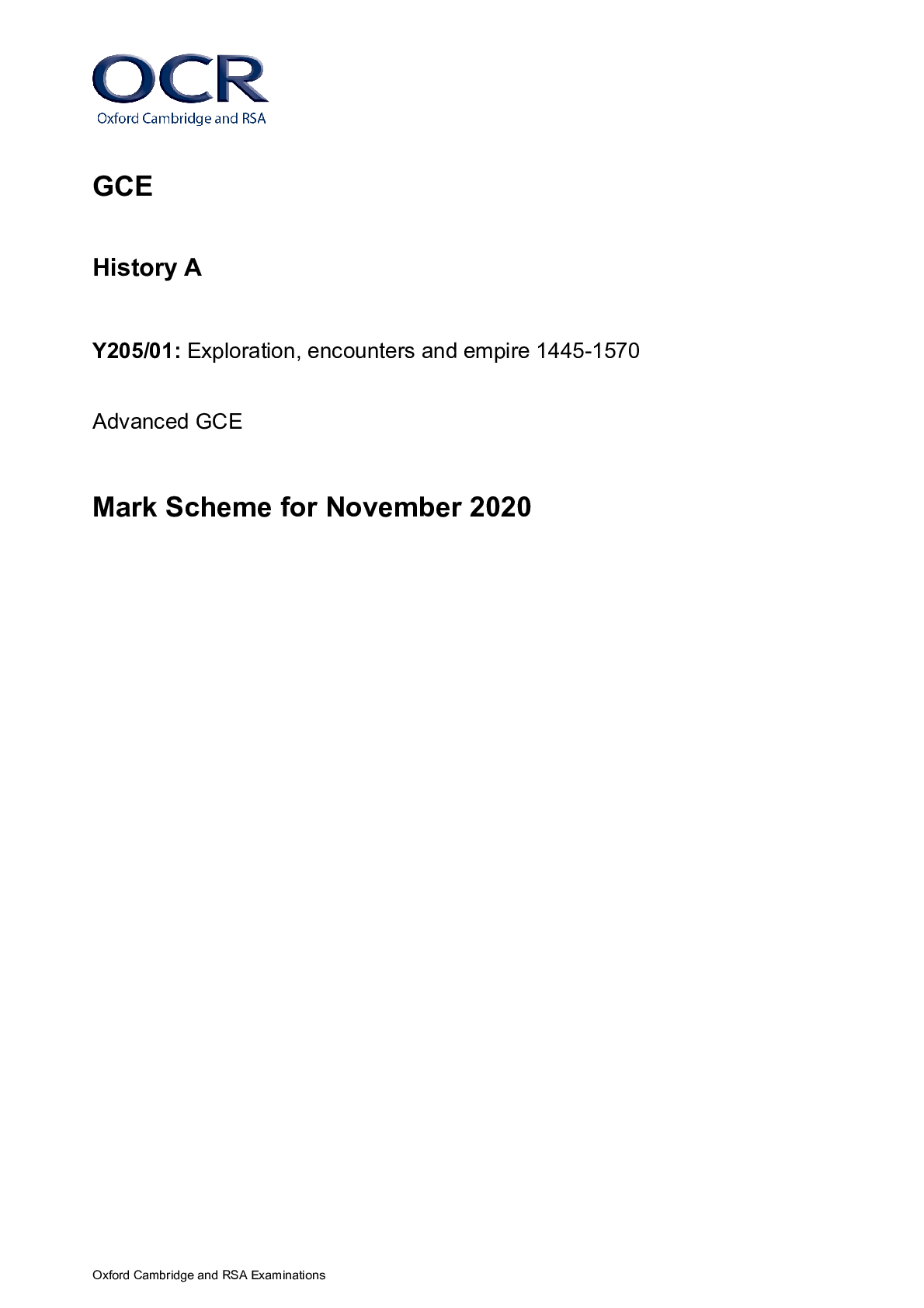
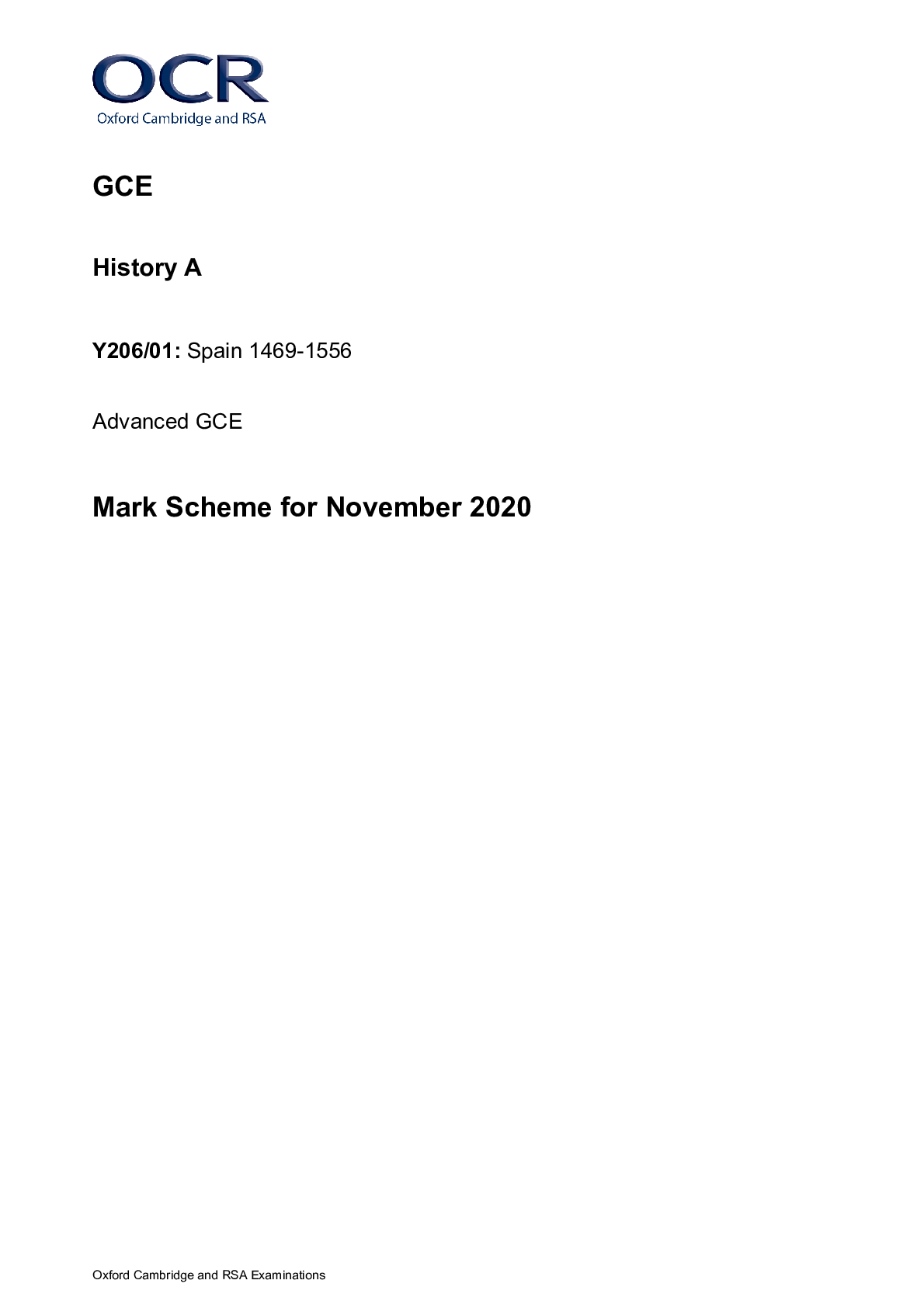
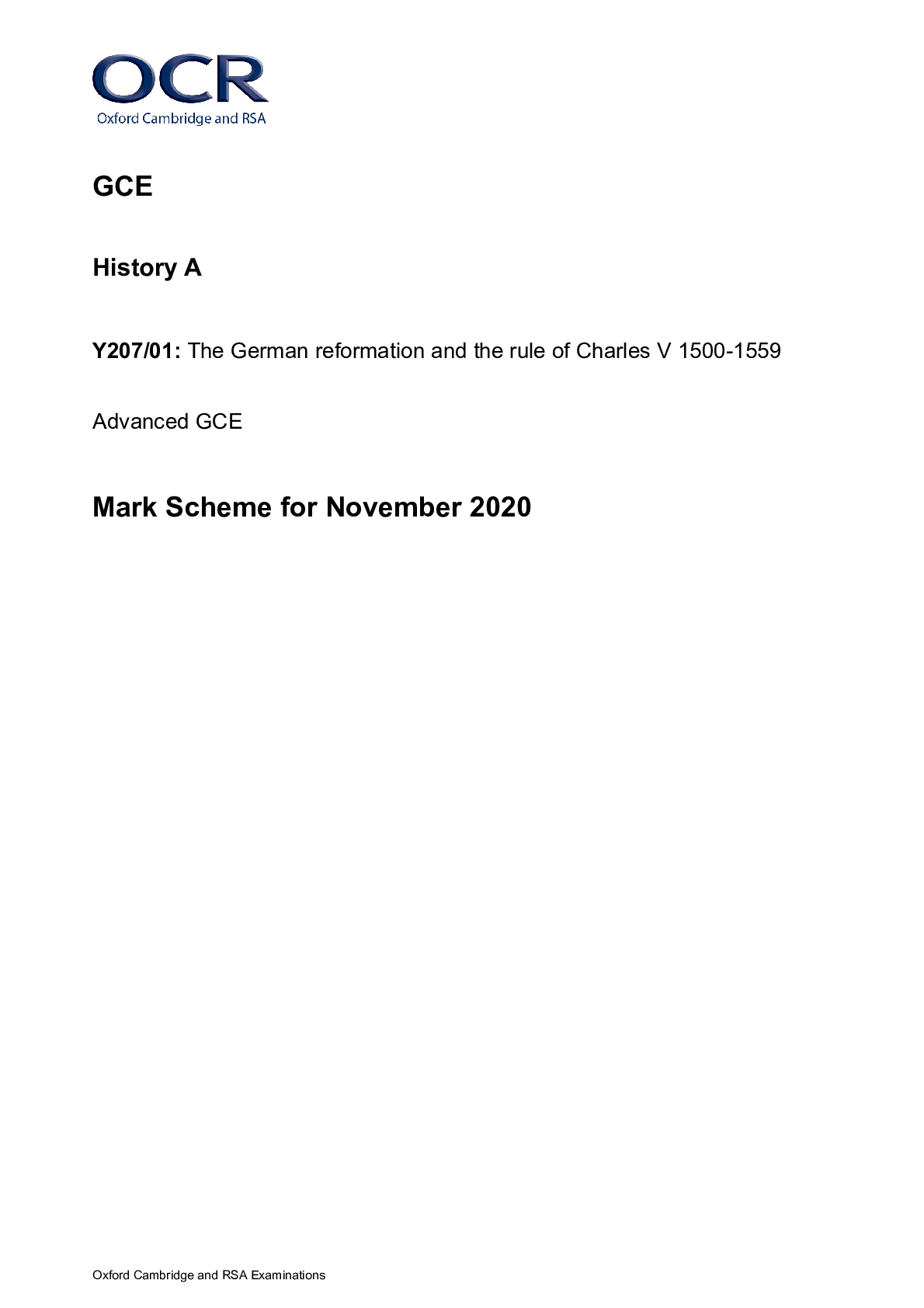
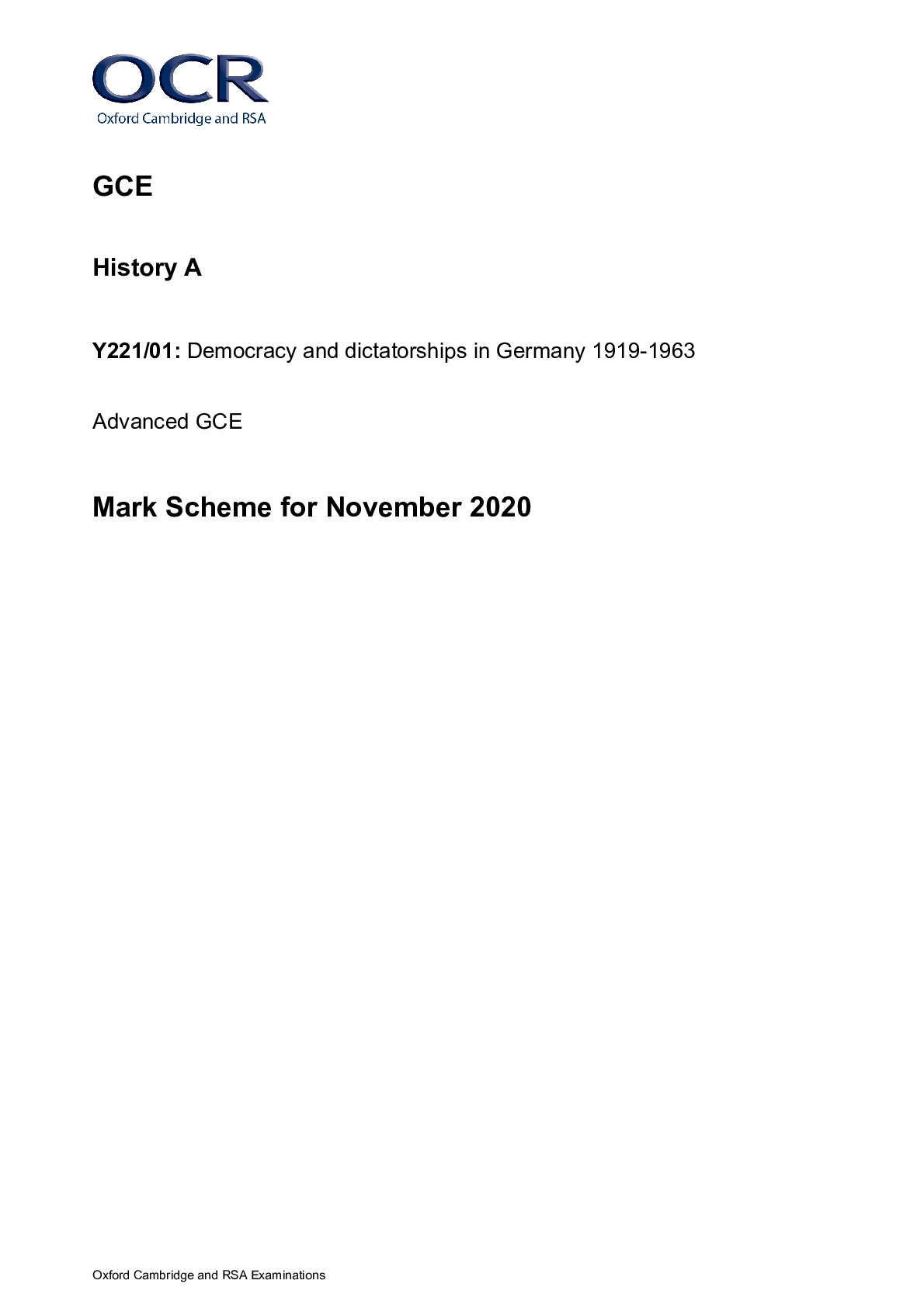

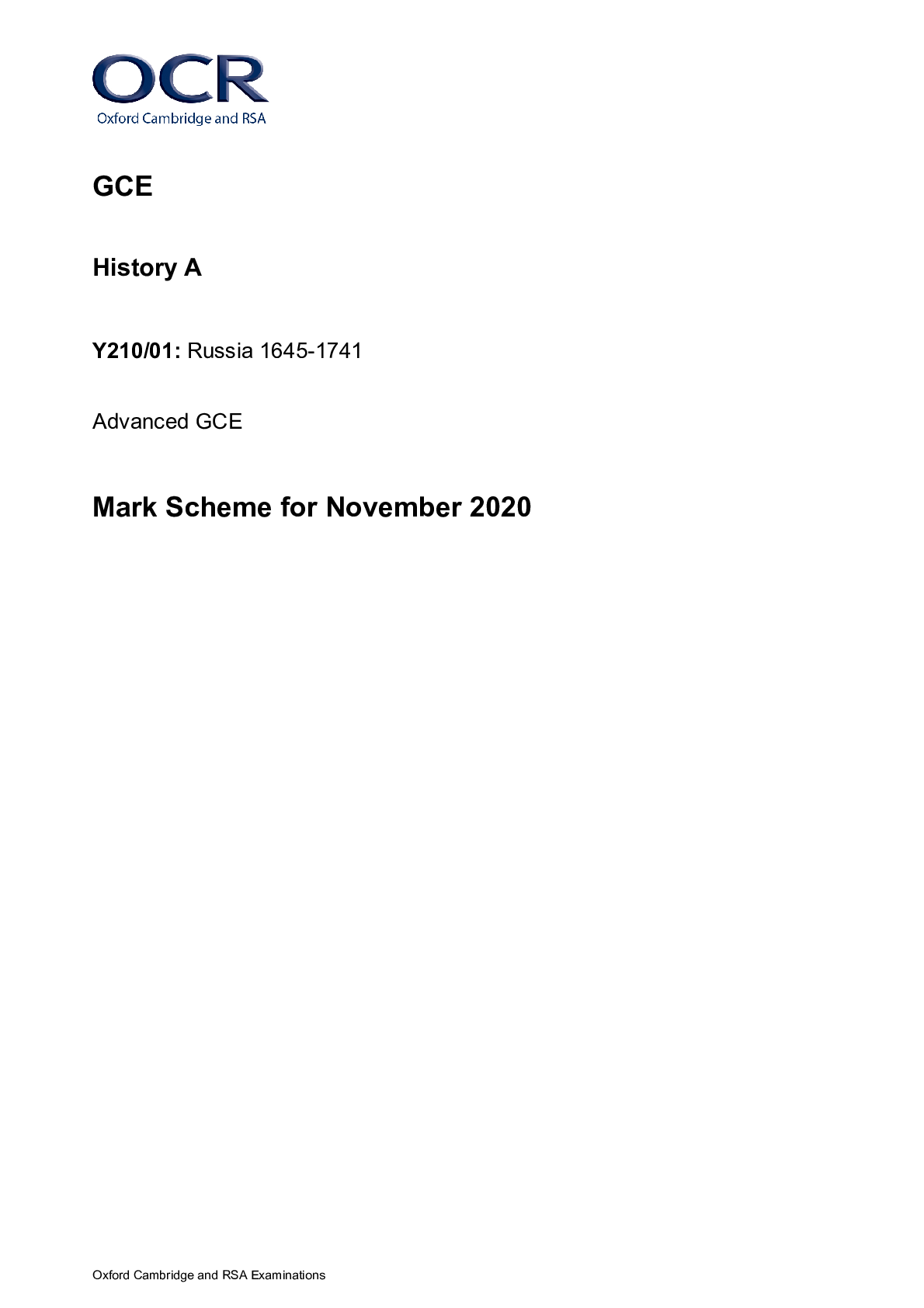
.png)


